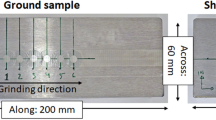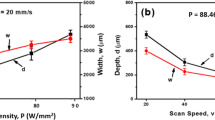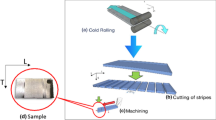Abstract
The excellent strength, toughness, and corrosion resistance of high-strength stainless steel has led to its extensive use in the chemical, nuclear, aerospace, and aviation industries. To shape this hard-to-cut material, electrochemical machining is a promising process. However, few reports have focused on the electrochemical dissolution behavior of high-strength stainless steel. Therefore, we focus herein on the electrochemical dissolution behavior of S-04 high-strength stainless steel in NaNO3 aqueous solution. The current efficiency indicates that current density can be divided into three regions (I, II, and III). Interestingly, a black machined surface appears in regions II and III, and the machined surface is shiny for region III. X-ray photoelectron spectroscopy indicates that the black machined surface is mainly due to the presence of Fe3O4. In addition, γ-Fe2O3 was also detected on the black machined surface in region III, whereas both γ-Fe2O3 and α-Fe2O3 were also detected on the black machined surface in regions I and II. Moreover, dissolution morphologies examined by SEM/EDX at different current densities and machining times showed that a good surface finish of the S-04 specimen can be obtained in region III. Finally, grooves with black surfaces in regions II and III were obtained by electrochemical milling.
Graphic abstract


















Similar content being viewed by others
References
Jiang SH, Wang H, Wu Y, Liu XJ, Chen HH, Yao MJ, Gault B, Ponge D, Raabe D, Hirata A, Chen MW, Wang YD, Lu ZP (2017) Ultrastrong steel via minimal lattice misfit and high-density nanoprecipitation. Nature 544:460–464. https://doi.org/10.1038/nature22032
Raabe D, Ponge D, Dmitrieva O, Sander B (2009) Nanoprecipitate-hardened 1.5 GPa steels with unexpected high ductility. Scripta Mater 60:1141–1144. https://doi.org/10.1016/j.scriptamat.2009.02.062
Tian JL, Wang W, Shahzad MB, Yan W, Shan YY, Jiang ZH, Yamg K (2017) A new maraging stainless steel with excellent strength–toughness–corrosion synergy. Materials 10:1293. https://doi.org/10.3390/ma10111293
Li YC, Yan W, Cotton JD, Ryan GJ, Shen YF, Wang W, Shan YY, Yang K (2015) A new 1.9 GPa maraging stainless steel strengthened by multiple precipitating species. Mater Design 82:56–63. https://doi.org/10.1016/j.matdes.2015.05.042
Guo Z, Sha W, Vaumousse D (2003) Microstructural evolution in a PH13-8 stainless steel after ageing. Acta Mater 51:101–116. https://doi.org/10.1016/S1359-6454(02)00353-1
Palanisamy D, Balasubramanian K, Manikandan N, Arulkirubakaran D, Ramesh R (2019) Machinability analysis of high strength materials with Cryo-Treated textured tungsten carbide inserts. Mater Manuf Process 34:502–510. https://doi.org/10.1080/10426914.2019.1566612
Palanisamy D, Senthil P (2018) A comparative study on machinability of cryo-treated and peak aged 15Cr-5Ni precipitation hardened stainless steel. Measurement 116:162–169. https://doi.org/10.1016/j.measurement.2017.11.008
Chinchanikar S, Choudhury SK (2013) Investigations on machinability aspects of hardened AISI 4340 steel at different levels of hardness using coated carbide tools. Int J Refract Met Hard Mater 38:124–133. https://doi.org/10.1016/j.ijrmhm.2013.01.013
Mohanty A, Gangopadhyay S, Thakur A (2016) On applicability of multilayer coated tool in dry machining of aerospace grade stainless steel. Mater Manuf Process 31:869–879. https://doi.org/10.1080/10426914.2015.1070413
Yadav US, Yadava V (2015) Experimental modeling and multiobjective optimization of electrical discharge drilling of aerospace superalloy material. Proc IMechE B 229:1764–1780. https://doi.org/10.1177/0954405414539299
Yang CB, Lin CG, Chiang HL, Chen CC (2017) Single and multiobjective optimization of Inconel 718 nickel-based superalloy in the wire electrical discharge machining. Int J Adv Manuf Technol 93:3075–3084. https://doi.org/10.1007/s00170-017-0758-3
Hinduja S, Pattavanitch J (2016) Experimental and numerical investigations in electro-chemical milling. CIRP J Manuf Sci Technol 12:79–89. https://doi.org/10.1016/j.cirpj.2015.07.003
Kozak J (1998) Mathematical models for computer simulation of electrochemical machining processes. J Mater Process Technol 76:170–175. https://doi.org/10.1016/S0924-0136(97)00333-6
Walther B, Schilm J, Michaelis A, Lohrengel MM (2007) Electrochemical dissolution of hard metal alloys. Electrochim Acta 52:7732–7737. https://doi.org/10.1016/j.electacta.2006.12.038
Liu WD, Ao SS, Li Y, Liu ZM, Wang ZM, Luo Z, Wang ZP, Song RF (2017) Jet electrochemical machining of TB6 titanium alloy. Int J Adv Manuf Technol 90:2397–2409. https://doi.org/10.1007/s00170-016-9500-9
Liu WD, Ao SS, Li Y, Liu ZM, Zhang H, Manladan SM, Luo Z, Wang ZP (2017) Effect of anodic behavior on electrochemical machining of TB6 titanium alloy. Electrochim Acta 233:190–200. https://doi.org/10.1016/j.electacta.2017.03.025
Liu Y, Qu NS (2019) Electrochemical milling of TB6 titanium alloy in NaNO3 solution. J Electrochem Soc 166:E35–E49. https://doi.org/10.1149/2.1181902jes
Wang F, Zhao JS, Lv YM, Yang ZW, Yao J, He YF, Tian ZJ (2017) Electrochemical machining of deep narrow slits on TB6 titanium alloys. Int J Adv Manuf Technol 92:3063–3071. https://doi.org/10.1007/s00170-017-0392-0
Weinmann M, Stolpe M, Weber O, Busch R, Natter H (2015) Electrochemical dissolution behaviour of Ti90Al6V4 and Ti60Al40 used for ECM applications. J Solid State Electr 19:485–495. https://doi.org/10.1007/s10008-014-2621-x
Anasane SS, Bhattacharyya B (2016) Experimental investigation on suitability of electrolytes for electrochemical micromachining of titanium. Int J Adv Manuf Technol 86:2147–2160. https://doi.org/10.1007/s00170-015-8309-2
He HD, Qu NS, Zeng YB, Fang XL, Yao YY (2016) Machining accuracy in pulsed wire electrochemical machining of γ-TiAl alloy. Int J Adv Manuf Technol 86:2353–2359. https://doi.org/10.1007/s00170-016-8402-1
Niu S, Qu NS, Fu SX, Fang XL, Li HS (2017) Investigation of inner-jet electrochemical milling of nickel-based alloy GH4169/Inconel 718. Int J Adv Manuf Technol 93:2123–2132. https://doi.org/10.1007/s00170-017-0680-8
Wang XD, Qu NS, Guo PF, Fang XL, Lin X (2017) Electrochemical machining properties of the laser rapid formed inconel 718 alloy in NaNO3 solution. J Electrochem Soc 164:E548–E559. https://doi.org/10.1149/2.1221714jes
Wang XD, Qu NS, Fang XL (2019) Reducing stray corrosion in jet electrochemical milling by adjusting the jet shape. J Mater Process Technol 264:240–248. https://doi.org/10.1016/j.jmatprotec.2018.09.017
Wang DY, Zhu ZW, Wang NF, Zhu D, Wang HR (2015) Investigation of the electrochemical dissolution behavior of Inconel 718 and 304 stainless steel at low current density in NaNO3 solution. Electrochim Acta 156:301–307. https://doi.org/10.1016/j.electacta.2014.12.155
Ge YC, Zhu ZW, Wang DY (2017) Electrochemical dissolution behavior of the nickel-based cast superalloy K423A in NaNO3 solution. Electrochim Acta 253:379–389. https://doi.org/10.1016/j.electacta.2017.09.046
Huang CA, Chen YC, Chang JH (2008) The electrochemical polishing behavior of the Inconel 718 alloy in perchloric-acetic mixed acids. Corros Sci 50:480–489. https://doi.org/10.1016/j.corsci.2007.07.005
Wang YD, Xu ZY, Zhang A (2019) Comparison of the electrochemical dissolution behavior of extruded and casted Ti-48Al-2Cr-2Nb alloys in NaNO3 solution. J Electrochem Soc 166:E347–E357. https://doi.org/10.1149/2.0501912jes
Mohammadi F, Nickchi T, Attar MM, Alfantazi A (2011) EIS study of potentiostatically formed passive film on 304 stainless steel. Electrochim Acta 56:8727–8733. https://doi.org/10.1016/j.electacta.2011.07.072
Fattah-alhosseini A, Saatchi A, Golozar MA et al (2009) The transpassive dissolution mechanism of 316L stainless steel. Electrochim Acta 54:3645–3650. https://doi.org/10.1016/j.electacta.2009.01.040
Olefjord I, Brox B, Jelvestam U (1985) Surface composition of stainless steel during anodic dissolution and passivation studied by ESCA. J Electrochem Soc 132:2854–2861. https://doi.org/10.1149/1.2113683
Rosenfeld IL, Danilov IS, Oranskaya RN (1978) Breakdown of the passive state and repassivation of stainless steels. J Electrochem Soc 125:1729–1735. https://doi.org/10.1149/1.2131284
Gao CP, Qu NS, Ding B, Shen YZ (2019) An insight into cathodic reactions during wire elelctrochemical micromachining in aqueous hydrochloric acid solution. Electrochim Acta 295:67–74. https://doi.org/10.1016/j.electacta.2018.10.140
Lohrengel MM, Klüppel I, Rosenkranz C, Bettermann H, Schultze JW (2003) Microscopic investigations of electrochemical machining of Fe in NaNO3. Electrochim Acta 48:3203–3211. https://doi.org/10.1016/S0013-4686(03)00372-4
Leese RJ, Ivanov A (2016) Electrochemical micromachining: an introduction. Adv Mech Eng 8:1–13. https://doi.org/10.1177/1687814015626860
Piao T, Park SM (1997) Spectroelectrochemical studies of passive and transpassive breakdown of reactions of stainless steel. J Electrochem Soc 144:3371–3377. https://doi.org/10.1149/1.1838021
Lohrengel MM, Rosenkranz C (2005) Microelectrochemical surface and product investigations during electrochemical machining (ECM) in NaNO3. Corros Sci 47:785–794. https://doi.org/10.1016/j.corsci.2004.07.023
Wang DY, Zhu ZW, He B, Ge YC, Zhu D (2017) Effect of the breakdown time of a passive film on the electrochemical machining of rotating cylindrical electrode in NaNO3 solution. J Mater Process Technol 239:251–257. https://doi.org/10.1016/j.jmatprotec.2016.08.023
Rosenkranz C, Lohrengel MM, Schultze JW (2005) The surface structure during pulsed ECM of iron in NaNO3. Electrochim Acta 50:2009–2016. https://doi.org/10.1016/j.electacta.2004.09.010
Oku M, Hirokawa K (1976) X-ray photoelectron spectroscopy of Co3O4, Fe3O4, Mn3O4 and related compounds. J Electron Spectrosc 8:475–481. https://doi.org/10.1016/0368-2048(76)80034-5
Tan BJ, Klabunde KJ, Sherwood PMA (1990) X-ray photoelectron spectroscopy studies of solvated metal atom dispersed catalysts. Monometallic iron and bimetallic iron-cobalt particles on alumina. Chem Mater 2:186–191. https://doi.org/10.1021/cm00008a021
Lu J, Jiao XL, Chen DR, Li W (2009) Solvothermal synthesis and characterization of Fe3O4 and γ-Fe2O3 nanoplates. J Phys Chem C 113:4012–4017. https://doi.org/10.1021/jp810583e
Mills P, Sullivan J (1983) A study of the core level electrons in iron and its three oxides by means of X-ray photoelectron spectroscopy. J Phys D 5:723–732. https://doi.org/10.1088/0022-3727/16/5/005
Zhang X, Niu YA, Meng XD, Li Y, Zhao JP (2013) Structural evolution and characteristics of the phase transformations between a-Fe2O3, Fe3O4 and c-Fe2O3 nanoparticles under reducing and oxidizing atmospheres. CrystEngComm 15:8166–8172. https://doi.org/10.1039/c3ce41269e
Acknowledgements
This work was supported by the National Key Research and Development Program of China (Grant No. 2018YFB1105900), National Natural Science Foundation of China for Creative Research Groups (Grant No. 51921003) and “333 Engineering” of Jiangsu Province (Grant No. BRA2018035).
Author information
Authors and Affiliations
Corresponding author
Additional information
Publisher's Note
Springer Nature remains neutral with regard to jurisdictional claims in published maps and institutional affiliations.
Rights and permissions
About this article
Cite this article
Wang, M., Qu, N. Electrochemical dissolution behavior of S-04 high-strength stainless steel in NaNO3 aqueous solution. J Appl Electrochem 50, 1149–1163 (2020). https://doi.org/10.1007/s10800-020-01469-2
Received:
Accepted:
Published:
Issue Date:
DOI: https://doi.org/10.1007/s10800-020-01469-2




